Management Information Systems for SCANDO: A Detailed Report
VerifiedAdded on 2021/02/21
|12
|4190
|62
Report
AI Summary
This report delves into the realm of Management Information Systems (MIS), focusing on their application and strategic importance for SCANDO. It begins by defining MIS and its role in organizational functions, emphasizing IT systems' purpose. The report evaluates various aspects, including data storage and processing methods, and provides an in-depth analysis of MIS, examining process, output, and impact evaluations. It also explores how information systems support value-added change within organizations, highlighting the significance of strategic information systems in fostering competitiveness. The report culminates by elucidating how SCANDO can leverage MIS to achieve a competitive edge in the global market, addressing key factors such as data management, system evaluation, and strategic alignment.
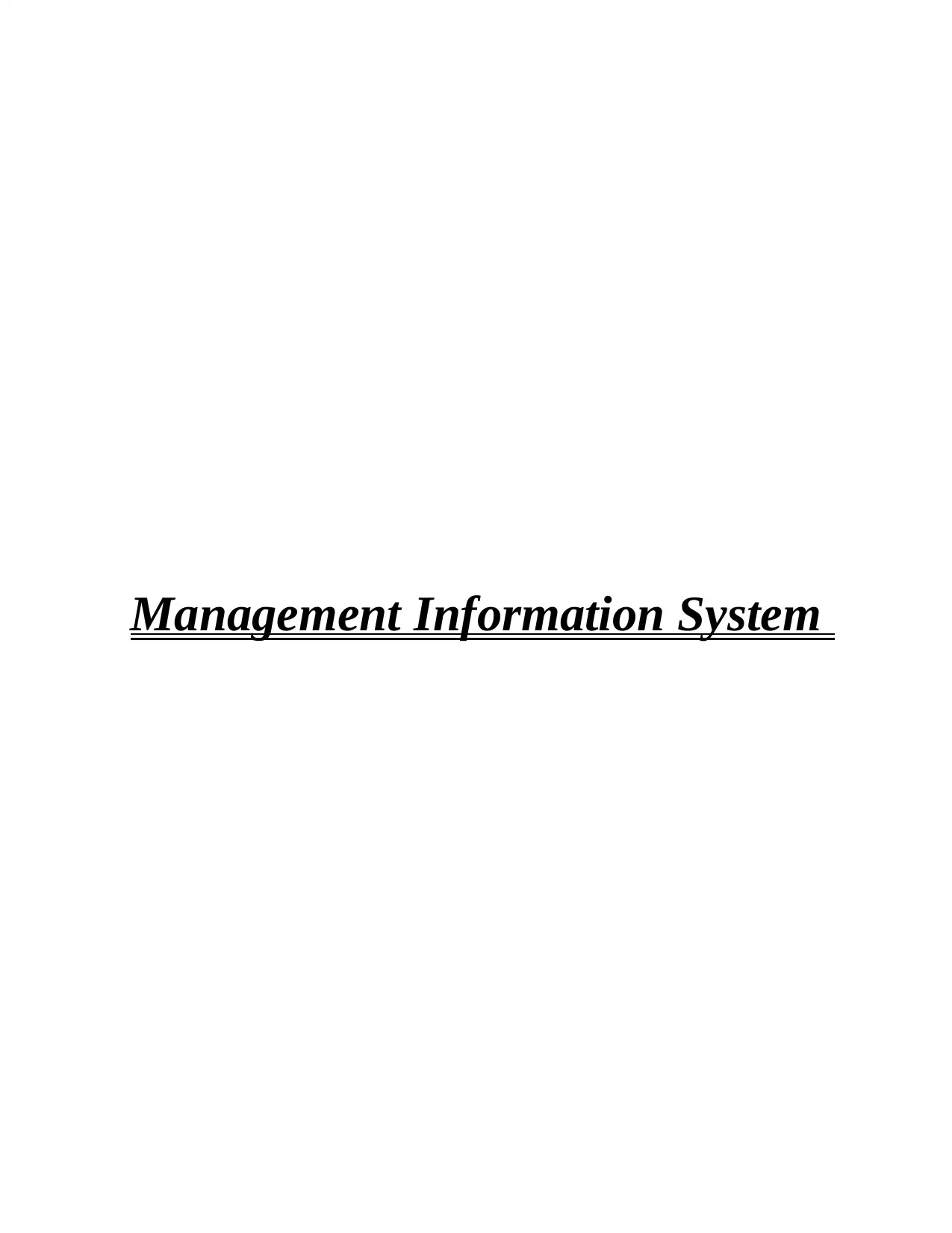
Management Information System
Paraphrase This Document
Need a fresh take? Get an instant paraphrase of this document with our AI Paraphraser
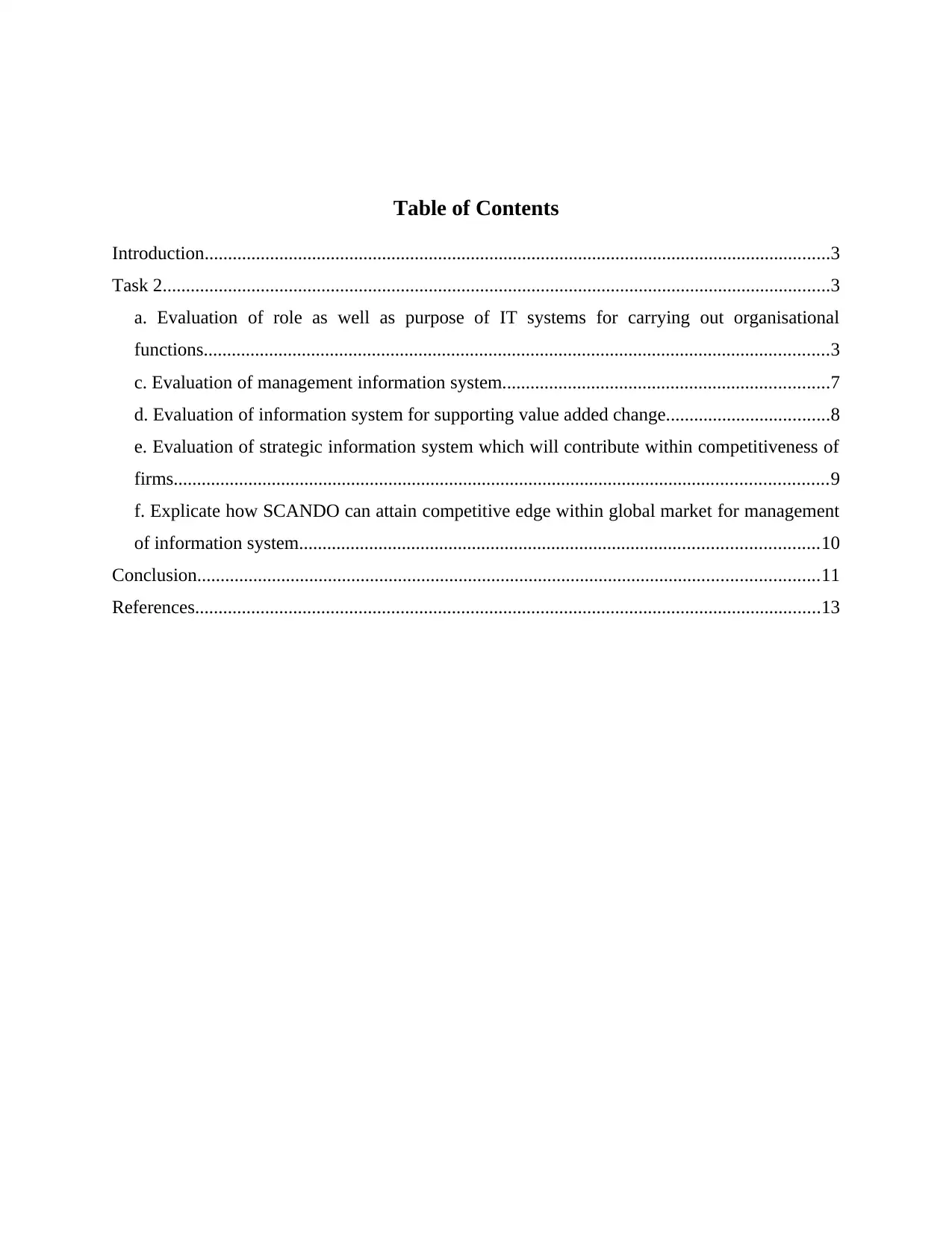
Table of Contents
Introduction......................................................................................................................................3
Task 2...............................................................................................................................................3
a. Evaluation of role as well as purpose of IT systems for carrying out organisational
functions......................................................................................................................................3
c. Evaluation of management information system......................................................................7
d. Evaluation of information system for supporting value added change...................................8
e. Evaluation of strategic information system which will contribute within competitiveness of
firms............................................................................................................................................9
f. Explicate how SCANDO can attain competitive edge within global market for management
of information system...............................................................................................................10
Conclusion.....................................................................................................................................11
References......................................................................................................................................13
Introduction......................................................................................................................................3
Task 2...............................................................................................................................................3
a. Evaluation of role as well as purpose of IT systems for carrying out organisational
functions......................................................................................................................................3
c. Evaluation of management information system......................................................................7
d. Evaluation of information system for supporting value added change...................................8
e. Evaluation of strategic information system which will contribute within competitiveness of
firms............................................................................................................................................9
f. Explicate how SCANDO can attain competitive edge within global market for management
of information system...............................................................................................................10
Conclusion.....................................................................................................................................11
References......................................................................................................................................13
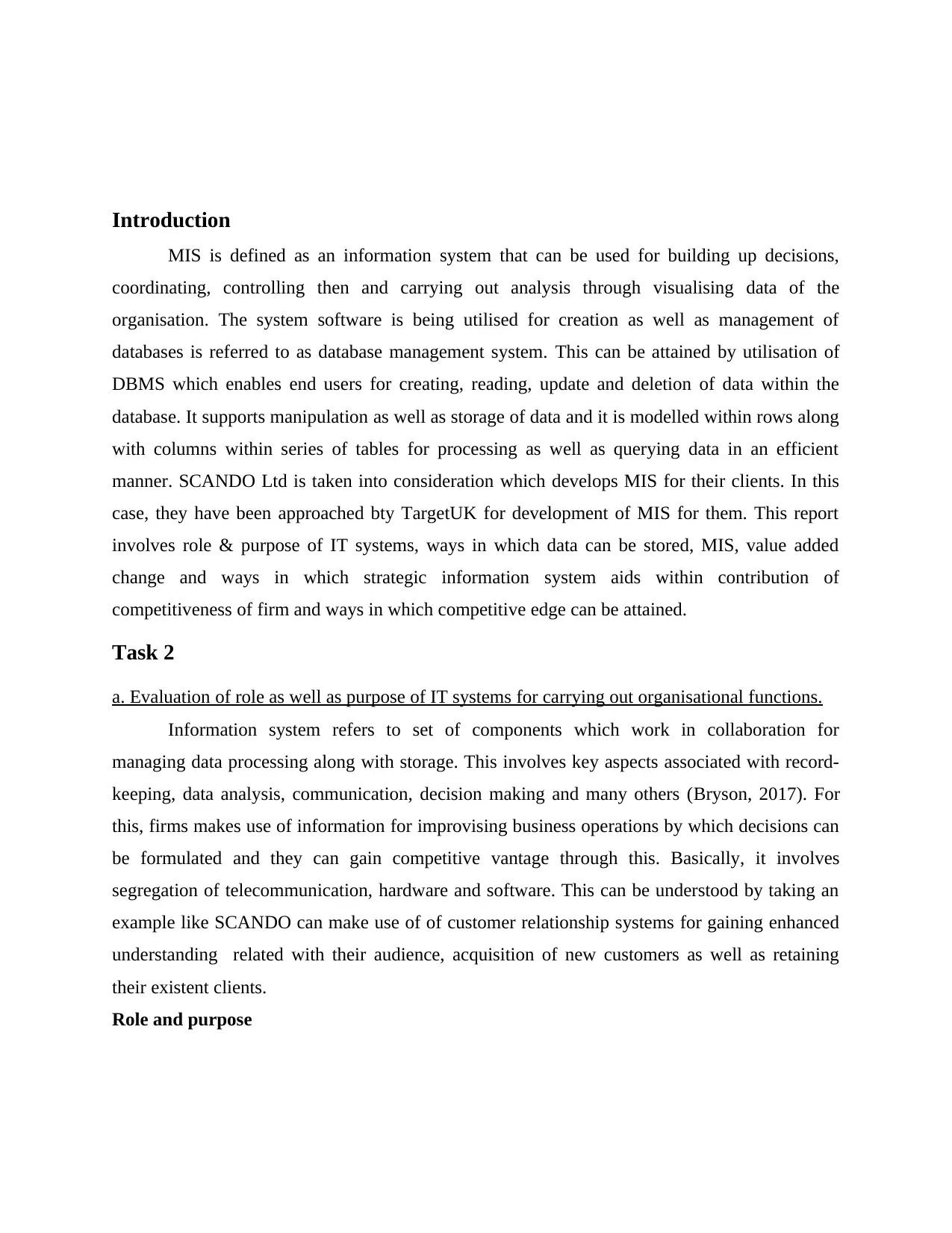
Introduction
MIS is defined as an information system that can be used for building up decisions,
coordinating, controlling then and carrying out analysis through visualising data of the
organisation. The system software is being utilised for creation as well as management of
databases is referred to as database management system. This can be attained by utilisation of
DBMS which enables end users for creating, reading, update and deletion of data within the
database. It supports manipulation as well as storage of data and it is modelled within rows along
with columns within series of tables for processing as well as querying data in an efficient
manner. SCANDO Ltd is taken into consideration which develops MIS for their clients. In this
case, they have been approached bty TargetUK for development of MIS for them. This report
involves role & purpose of IT systems, ways in which data can be stored, MIS, value added
change and ways in which strategic information system aids within contribution of
competitiveness of firm and ways in which competitive edge can be attained.
Task 2
a. Evaluation of role as well as purpose of IT systems for carrying out organisational functions.
Information system refers to set of components which work in collaboration for
managing data processing along with storage. This involves key aspects associated with record-
keeping, data analysis, communication, decision making and many others (Bryson, 2017). For
this, firms makes use of information for improvising business operations by which decisions can
be formulated and they can gain competitive vantage through this. Basically, it involves
segregation of telecommunication, hardware and software. This can be understood by taking an
example like SCANDO can make use of of customer relationship systems for gaining enhanced
understanding related with their audience, acquisition of new customers as well as retaining
their existent clients.
Role and purpose
MIS is defined as an information system that can be used for building up decisions,
coordinating, controlling then and carrying out analysis through visualising data of the
organisation. The system software is being utilised for creation as well as management of
databases is referred to as database management system. This can be attained by utilisation of
DBMS which enables end users for creating, reading, update and deletion of data within the
database. It supports manipulation as well as storage of data and it is modelled within rows along
with columns within series of tables for processing as well as querying data in an efficient
manner. SCANDO Ltd is taken into consideration which develops MIS for their clients. In this
case, they have been approached bty TargetUK for development of MIS for them. This report
involves role & purpose of IT systems, ways in which data can be stored, MIS, value added
change and ways in which strategic information system aids within contribution of
competitiveness of firm and ways in which competitive edge can be attained.
Task 2
a. Evaluation of role as well as purpose of IT systems for carrying out organisational functions.
Information system refers to set of components which work in collaboration for
managing data processing along with storage. This involves key aspects associated with record-
keeping, data analysis, communication, decision making and many others (Bryson, 2017). For
this, firms makes use of information for improvising business operations by which decisions can
be formulated and they can gain competitive vantage through this. Basically, it involves
segregation of telecommunication, hardware and software. This can be understood by taking an
example like SCANDO can make use of of customer relationship systems for gaining enhanced
understanding related with their audience, acquisition of new customers as well as retaining
their existent clients.
Role and purpose
⊘ This is a preview!⊘
Do you want full access?
Subscribe today to unlock all pages.

Trusted by 1+ million students worldwide
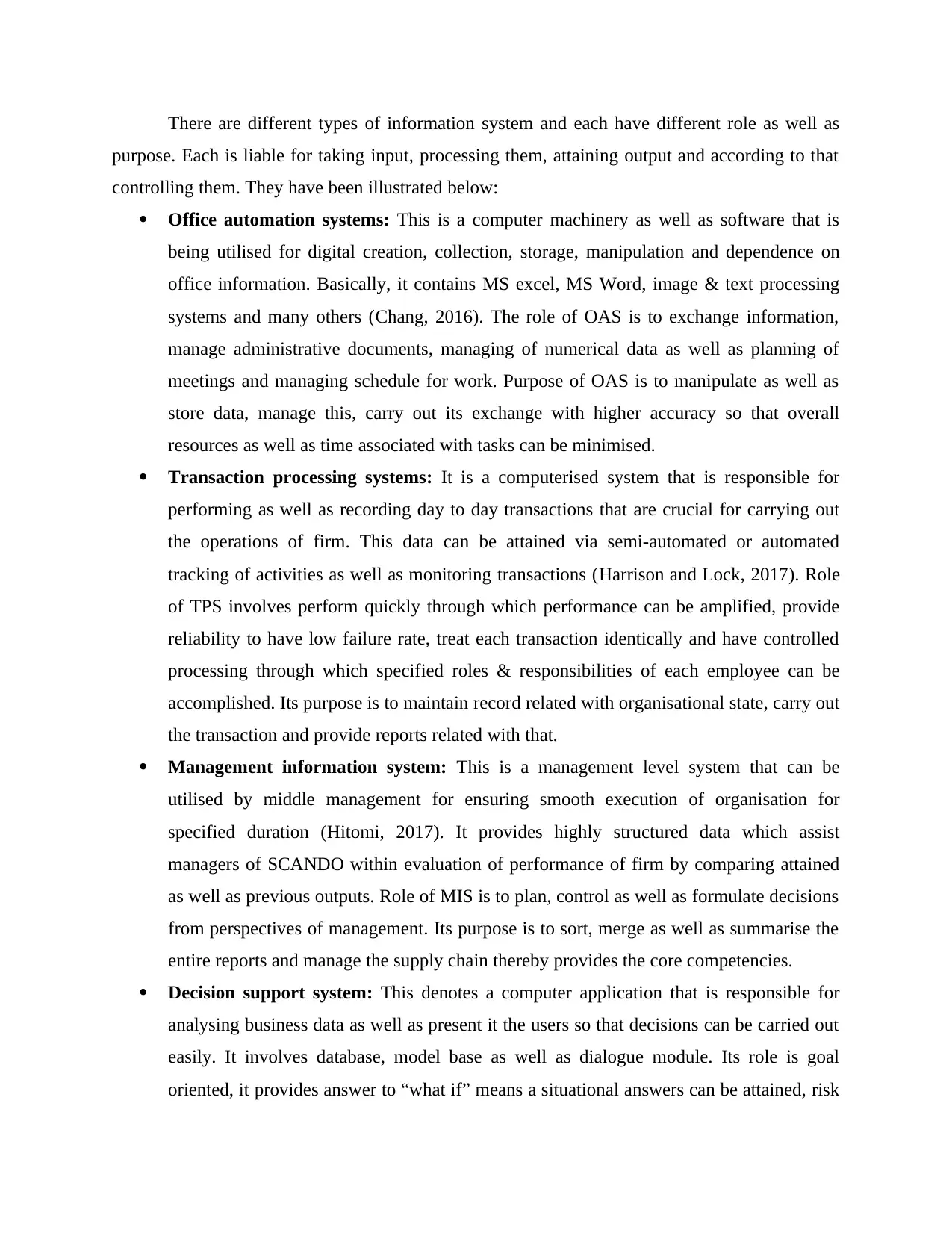
There are different types of information system and each have different role as well as
purpose. Each is liable for taking input, processing them, attaining output and according to that
controlling them. They have been illustrated below:
Office automation systems: This is a computer machinery as well as software that is
being utilised for digital creation, collection, storage, manipulation and dependence on
office information. Basically, it contains MS excel, MS Word, image & text processing
systems and many others (Chang, 2016). The role of OAS is to exchange information,
manage administrative documents, managing of numerical data as well as planning of
meetings and managing schedule for work. Purpose of OAS is to manipulate as well as
store data, manage this, carry out its exchange with higher accuracy so that overall
resources as well as time associated with tasks can be minimised.
Transaction processing systems: It is a computerised system that is responsible for
performing as well as recording day to day transactions that are crucial for carrying out
the operations of firm. This data can be attained via semi-automated or automated
tracking of activities as well as monitoring transactions (Harrison and Lock, 2017). Role
of TPS involves perform quickly through which performance can be amplified, provide
reliability to have low failure rate, treat each transaction identically and have controlled
processing through which specified roles & responsibilities of each employee can be
accomplished. Its purpose is to maintain record related with organisational state, carry out
the transaction and provide reports related with that.
Management information system: This is a management level system that can be
utilised by middle management for ensuring smooth execution of organisation for
specified duration (Hitomi, 2017). It provides highly structured data which assist
managers of SCANDO within evaluation of performance of firm by comparing attained
as well as previous outputs. Role of MIS is to plan, control as well as formulate decisions
from perspectives of management. Its purpose is to sort, merge as well as summarise the
entire reports and manage the supply chain thereby provides the core competencies.
Decision support system: This denotes a computer application that is responsible for
analysing business data as well as present it the users so that decisions can be carried out
easily. It involves database, model base as well as dialogue module. Its role is goal
oriented, it provides answer to “what if” means a situational answers can be attained, risk
purpose. Each is liable for taking input, processing them, attaining output and according to that
controlling them. They have been illustrated below:
Office automation systems: This is a computer machinery as well as software that is
being utilised for digital creation, collection, storage, manipulation and dependence on
office information. Basically, it contains MS excel, MS Word, image & text processing
systems and many others (Chang, 2016). The role of OAS is to exchange information,
manage administrative documents, managing of numerical data as well as planning of
meetings and managing schedule for work. Purpose of OAS is to manipulate as well as
store data, manage this, carry out its exchange with higher accuracy so that overall
resources as well as time associated with tasks can be minimised.
Transaction processing systems: It is a computerised system that is responsible for
performing as well as recording day to day transactions that are crucial for carrying out
the operations of firm. This data can be attained via semi-automated or automated
tracking of activities as well as monitoring transactions (Harrison and Lock, 2017). Role
of TPS involves perform quickly through which performance can be amplified, provide
reliability to have low failure rate, treat each transaction identically and have controlled
processing through which specified roles & responsibilities of each employee can be
accomplished. Its purpose is to maintain record related with organisational state, carry out
the transaction and provide reports related with that.
Management information system: This is a management level system that can be
utilised by middle management for ensuring smooth execution of organisation for
specified duration (Hitomi, 2017). It provides highly structured data which assist
managers of SCANDO within evaluation of performance of firm by comparing attained
as well as previous outputs. Role of MIS is to plan, control as well as formulate decisions
from perspectives of management. Its purpose is to sort, merge as well as summarise the
entire reports and manage the supply chain thereby provides the core competencies.
Decision support system: This denotes a computer application that is responsible for
analysing business data as well as present it the users so that decisions can be carried out
easily. It involves database, model base as well as dialogue module. Its role is goal
oriented, it provides answer to “what if” means a situational answers can be attained, risk
Paraphrase This Document
Need a fresh take? Get an instant paraphrase of this document with our AI Paraphraser
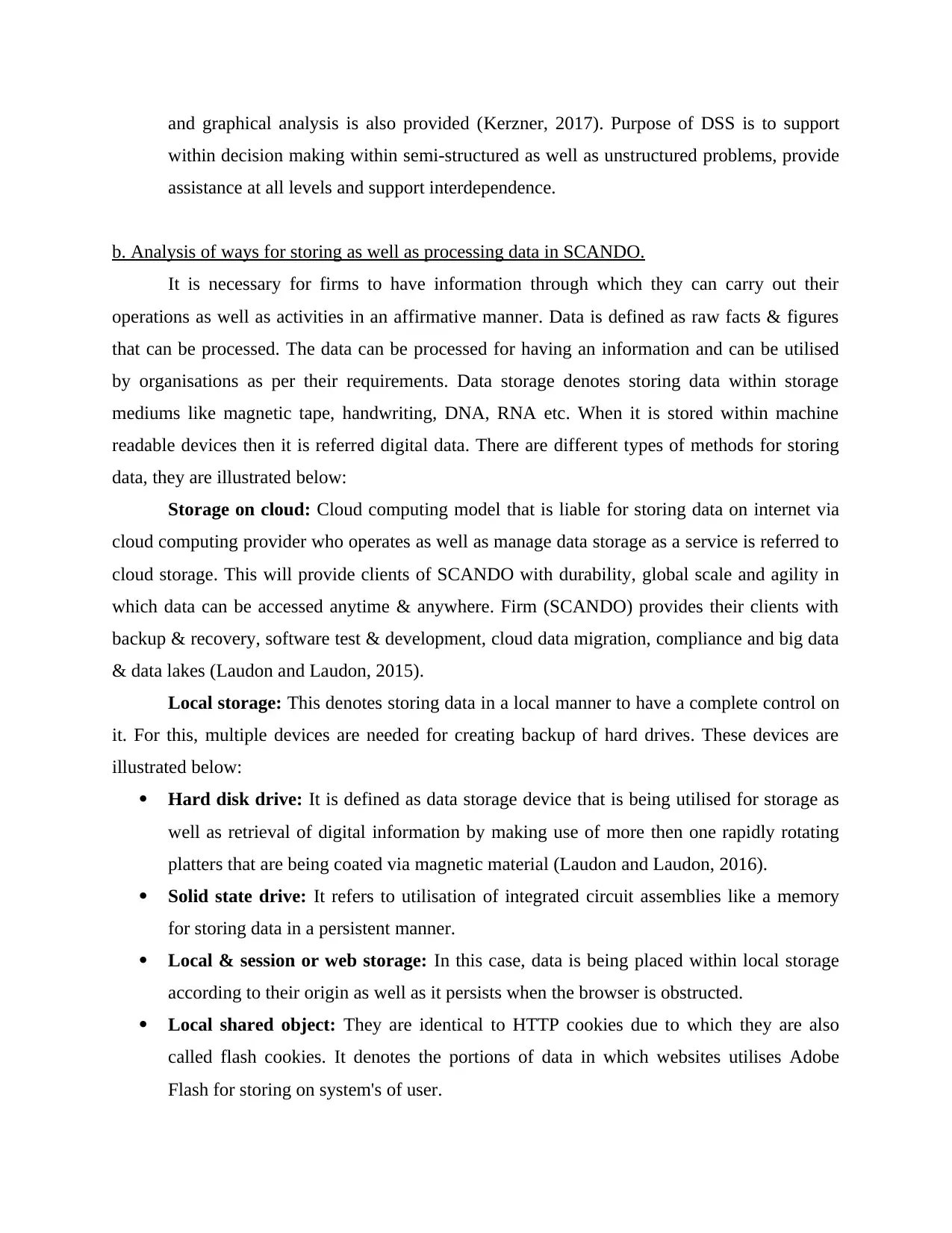
and graphical analysis is also provided (Kerzner, 2017). Purpose of DSS is to support
within decision making within semi-structured as well as unstructured problems, provide
assistance at all levels and support interdependence.
b. Analysis of ways for storing as well as processing data in SCANDO.
It is necessary for firms to have information through which they can carry out their
operations as well as activities in an affirmative manner. Data is defined as raw facts & figures
that can be processed. The data can be processed for having an information and can be utilised
by organisations as per their requirements. Data storage denotes storing data within storage
mediums like magnetic tape, handwriting, DNA, RNA etc. When it is stored within machine
readable devices then it is referred digital data. There are different types of methods for storing
data, they are illustrated below:
Storage on cloud: Cloud computing model that is liable for storing data on internet via
cloud computing provider who operates as well as manage data storage as a service is referred to
cloud storage. This will provide clients of SCANDO with durability, global scale and agility in
which data can be accessed anytime & anywhere. Firm (SCANDO) provides their clients with
backup & recovery, software test & development, cloud data migration, compliance and big data
& data lakes (Laudon and Laudon, 2015).
Local storage: This denotes storing data in a local manner to have a complete control on
it. For this, multiple devices are needed for creating backup of hard drives. These devices are
illustrated below:
Hard disk drive: It is defined as data storage device that is being utilised for storage as
well as retrieval of digital information by making use of more then one rapidly rotating
platters that are being coated via magnetic material (Laudon and Laudon, 2016).
Solid state drive: It refers to utilisation of integrated circuit assemblies like a memory
for storing data in a persistent manner.
Local & session or web storage: In this case, data is being placed within local storage
according to their origin as well as it persists when the browser is obstructed.
Local shared object: They are identical to HTTP cookies due to which they are also
called flash cookies. It denotes the portions of data in which websites utilises Adobe
Flash for storing on system's of user.
within decision making within semi-structured as well as unstructured problems, provide
assistance at all levels and support interdependence.
b. Analysis of ways for storing as well as processing data in SCANDO.
It is necessary for firms to have information through which they can carry out their
operations as well as activities in an affirmative manner. Data is defined as raw facts & figures
that can be processed. The data can be processed for having an information and can be utilised
by organisations as per their requirements. Data storage denotes storing data within storage
mediums like magnetic tape, handwriting, DNA, RNA etc. When it is stored within machine
readable devices then it is referred digital data. There are different types of methods for storing
data, they are illustrated below:
Storage on cloud: Cloud computing model that is liable for storing data on internet via
cloud computing provider who operates as well as manage data storage as a service is referred to
cloud storage. This will provide clients of SCANDO with durability, global scale and agility in
which data can be accessed anytime & anywhere. Firm (SCANDO) provides their clients with
backup & recovery, software test & development, cloud data migration, compliance and big data
& data lakes (Laudon and Laudon, 2015).
Local storage: This denotes storing data in a local manner to have a complete control on
it. For this, multiple devices are needed for creating backup of hard drives. These devices are
illustrated below:
Hard disk drive: It is defined as data storage device that is being utilised for storage as
well as retrieval of digital information by making use of more then one rapidly rotating
platters that are being coated via magnetic material (Laudon and Laudon, 2016).
Solid state drive: It refers to utilisation of integrated circuit assemblies like a memory
for storing data in a persistent manner.
Local & session or web storage: In this case, data is being placed within local storage
according to their origin as well as it persists when the browser is obstructed.
Local shared object: They are identical to HTTP cookies due to which they are also
called flash cookies. It denotes the portions of data in which websites utilises Adobe
Flash for storing on system's of user.
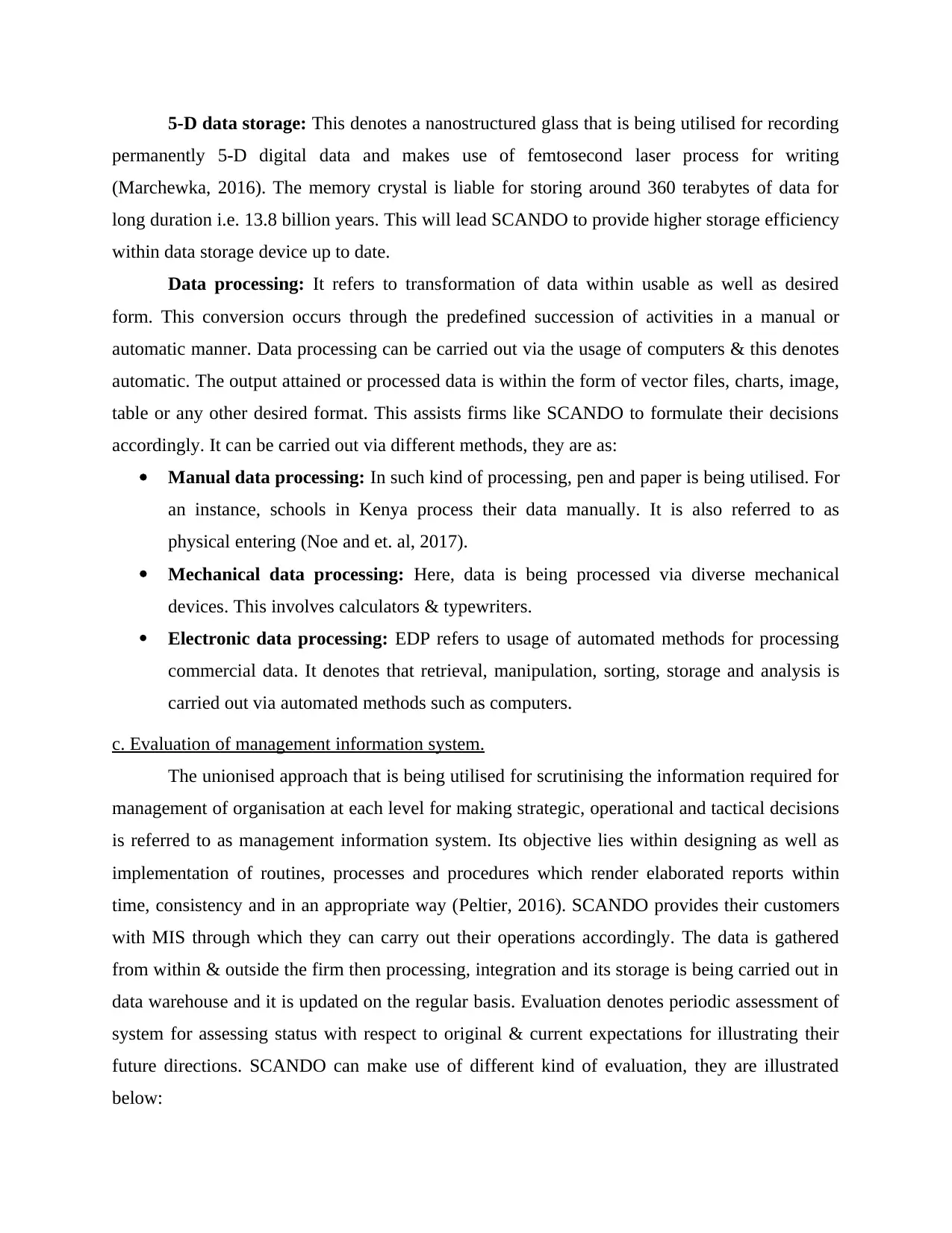
5-D data storage: This denotes a nanostructured glass that is being utilised for recording
permanently 5-D digital data and makes use of femtosecond laser process for writing
(Marchewka, 2016). The memory crystal is liable for storing around 360 terabytes of data for
long duration i.e. 13.8 billion years. This will lead SCANDO to provide higher storage efficiency
within data storage device up to date.
Data processing: It refers to transformation of data within usable as well as desired
form. This conversion occurs through the predefined succession of activities in a manual or
automatic manner. Data processing can be carried out via the usage of computers & this denotes
automatic. The output attained or processed data is within the form of vector files, charts, image,
table or any other desired format. This assists firms like SCANDO to formulate their decisions
accordingly. It can be carried out via different methods, they are as:
Manual data processing: In such kind of processing, pen and paper is being utilised. For
an instance, schools in Kenya process their data manually. It is also referred to as
physical entering (Noe and et. al, 2017).
Mechanical data processing: Here, data is being processed via diverse mechanical
devices. This involves calculators & typewriters.
Electronic data processing: EDP refers to usage of automated methods for processing
commercial data. It denotes that retrieval, manipulation, sorting, storage and analysis is
carried out via automated methods such as computers.
c. Evaluation of management information system.
The unionised approach that is being utilised for scrutinising the information required for
management of organisation at each level for making strategic, operational and tactical decisions
is referred to as management information system. Its objective lies within designing as well as
implementation of routines, processes and procedures which render elaborated reports within
time, consistency and in an appropriate way (Peltier, 2016). SCANDO provides their customers
with MIS through which they can carry out their operations accordingly. The data is gathered
from within & outside the firm then processing, integration and its storage is being carried out in
data warehouse and it is updated on the regular basis. Evaluation denotes periodic assessment of
system for assessing status with respect to original & current expectations for illustrating their
future directions. SCANDO can make use of different kind of evaluation, they are illustrated
below:
permanently 5-D digital data and makes use of femtosecond laser process for writing
(Marchewka, 2016). The memory crystal is liable for storing around 360 terabytes of data for
long duration i.e. 13.8 billion years. This will lead SCANDO to provide higher storage efficiency
within data storage device up to date.
Data processing: It refers to transformation of data within usable as well as desired
form. This conversion occurs through the predefined succession of activities in a manual or
automatic manner. Data processing can be carried out via the usage of computers & this denotes
automatic. The output attained or processed data is within the form of vector files, charts, image,
table or any other desired format. This assists firms like SCANDO to formulate their decisions
accordingly. It can be carried out via different methods, they are as:
Manual data processing: In such kind of processing, pen and paper is being utilised. For
an instance, schools in Kenya process their data manually. It is also referred to as
physical entering (Noe and et. al, 2017).
Mechanical data processing: Here, data is being processed via diverse mechanical
devices. This involves calculators & typewriters.
Electronic data processing: EDP refers to usage of automated methods for processing
commercial data. It denotes that retrieval, manipulation, sorting, storage and analysis is
carried out via automated methods such as computers.
c. Evaluation of management information system.
The unionised approach that is being utilised for scrutinising the information required for
management of organisation at each level for making strategic, operational and tactical decisions
is referred to as management information system. Its objective lies within designing as well as
implementation of routines, processes and procedures which render elaborated reports within
time, consistency and in an appropriate way (Peltier, 2016). SCANDO provides their customers
with MIS through which they can carry out their operations accordingly. The data is gathered
from within & outside the firm then processing, integration and its storage is being carried out in
data warehouse and it is updated on the regular basis. Evaluation denotes periodic assessment of
system for assessing status with respect to original & current expectations for illustrating their
future directions. SCANDO can make use of different kind of evaluation, they are illustrated
below:
⊘ This is a preview!⊘
Do you want full access?
Subscribe today to unlock all pages.

Trusted by 1+ million students worldwide
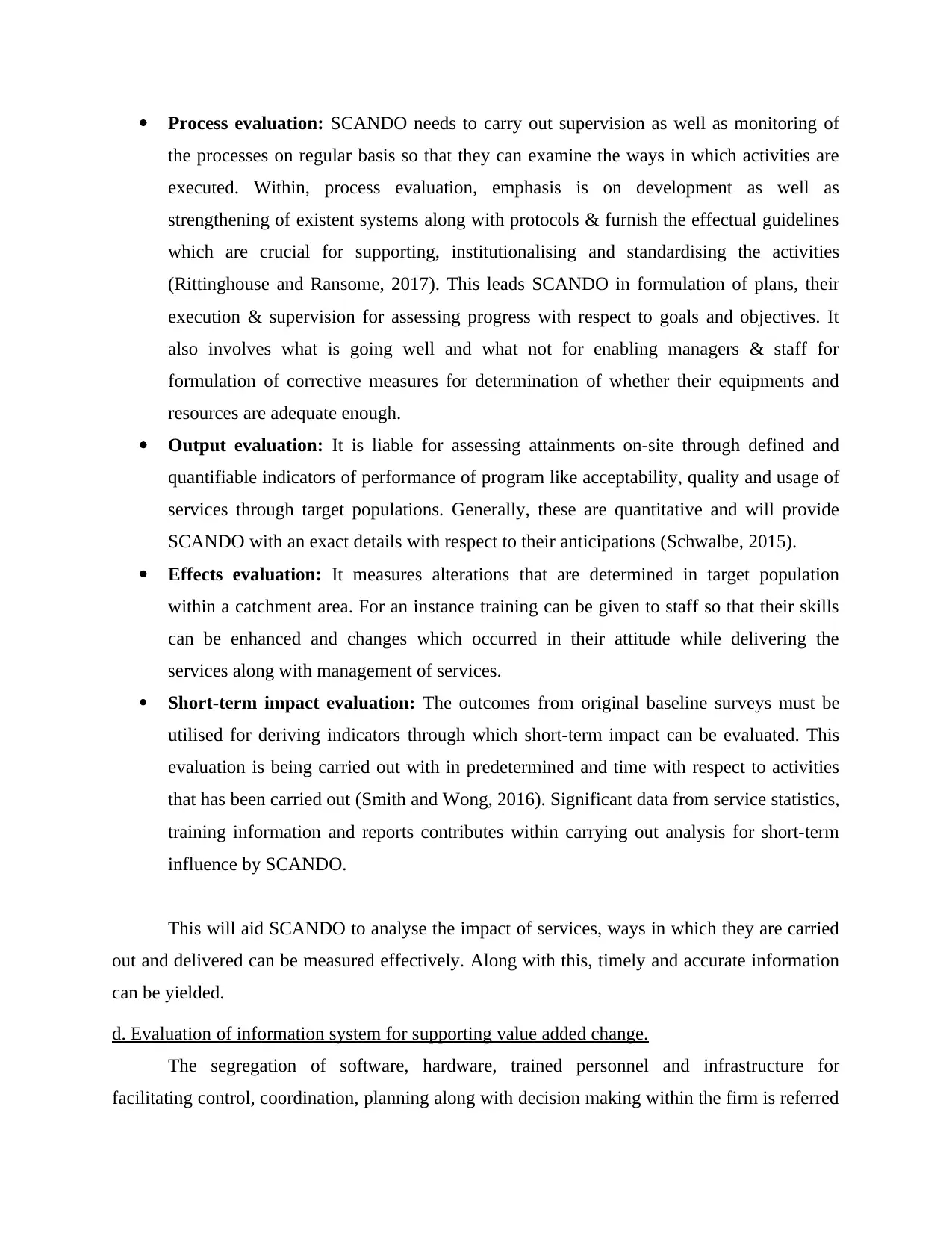
Process evaluation: SCANDO needs to carry out supervision as well as monitoring of
the processes on regular basis so that they can examine the ways in which activities are
executed. Within, process evaluation, emphasis is on development as well as
strengthening of existent systems along with protocols & furnish the effectual guidelines
which are crucial for supporting, institutionalising and standardising the activities
(Rittinghouse and Ransome, 2017). This leads SCANDO in formulation of plans, their
execution & supervision for assessing progress with respect to goals and objectives. It
also involves what is going well and what not for enabling managers & staff for
formulation of corrective measures for determination of whether their equipments and
resources are adequate enough.
Output evaluation: It is liable for assessing attainments on-site through defined and
quantifiable indicators of performance of program like acceptability, quality and usage of
services through target populations. Generally, these are quantitative and will provide
SCANDO with an exact details with respect to their anticipations (Schwalbe, 2015).
Effects evaluation: It measures alterations that are determined in target population
within a catchment area. For an instance training can be given to staff so that their skills
can be enhanced and changes which occurred in their attitude while delivering the
services along with management of services.
Short-term impact evaluation: The outcomes from original baseline surveys must be
utilised for deriving indicators through which short-term impact can be evaluated. This
evaluation is being carried out with in predetermined and time with respect to activities
that has been carried out (Smith and Wong, 2016). Significant data from service statistics,
training information and reports contributes within carrying out analysis for short-term
influence by SCANDO.
This will aid SCANDO to analyse the impact of services, ways in which they are carried
out and delivered can be measured effectively. Along with this, timely and accurate information
can be yielded.
d. Evaluation of information system for supporting value added change.
The segregation of software, hardware, trained personnel and infrastructure for
facilitating control, coordination, planning along with decision making within the firm is referred
the processes on regular basis so that they can examine the ways in which activities are
executed. Within, process evaluation, emphasis is on development as well as
strengthening of existent systems along with protocols & furnish the effectual guidelines
which are crucial for supporting, institutionalising and standardising the activities
(Rittinghouse and Ransome, 2017). This leads SCANDO in formulation of plans, their
execution & supervision for assessing progress with respect to goals and objectives. It
also involves what is going well and what not for enabling managers & staff for
formulation of corrective measures for determination of whether their equipments and
resources are adequate enough.
Output evaluation: It is liable for assessing attainments on-site through defined and
quantifiable indicators of performance of program like acceptability, quality and usage of
services through target populations. Generally, these are quantitative and will provide
SCANDO with an exact details with respect to their anticipations (Schwalbe, 2015).
Effects evaluation: It measures alterations that are determined in target population
within a catchment area. For an instance training can be given to staff so that their skills
can be enhanced and changes which occurred in their attitude while delivering the
services along with management of services.
Short-term impact evaluation: The outcomes from original baseline surveys must be
utilised for deriving indicators through which short-term impact can be evaluated. This
evaluation is being carried out with in predetermined and time with respect to activities
that has been carried out (Smith and Wong, 2016). Significant data from service statistics,
training information and reports contributes within carrying out analysis for short-term
influence by SCANDO.
This will aid SCANDO to analyse the impact of services, ways in which they are carried
out and delivered can be measured effectively. Along with this, timely and accurate information
can be yielded.
d. Evaluation of information system for supporting value added change.
The segregation of software, hardware, trained personnel and infrastructure for
facilitating control, coordination, planning along with decision making within the firm is referred
Paraphrase This Document
Need a fresh take? Get an instant paraphrase of this document with our AI Paraphraser
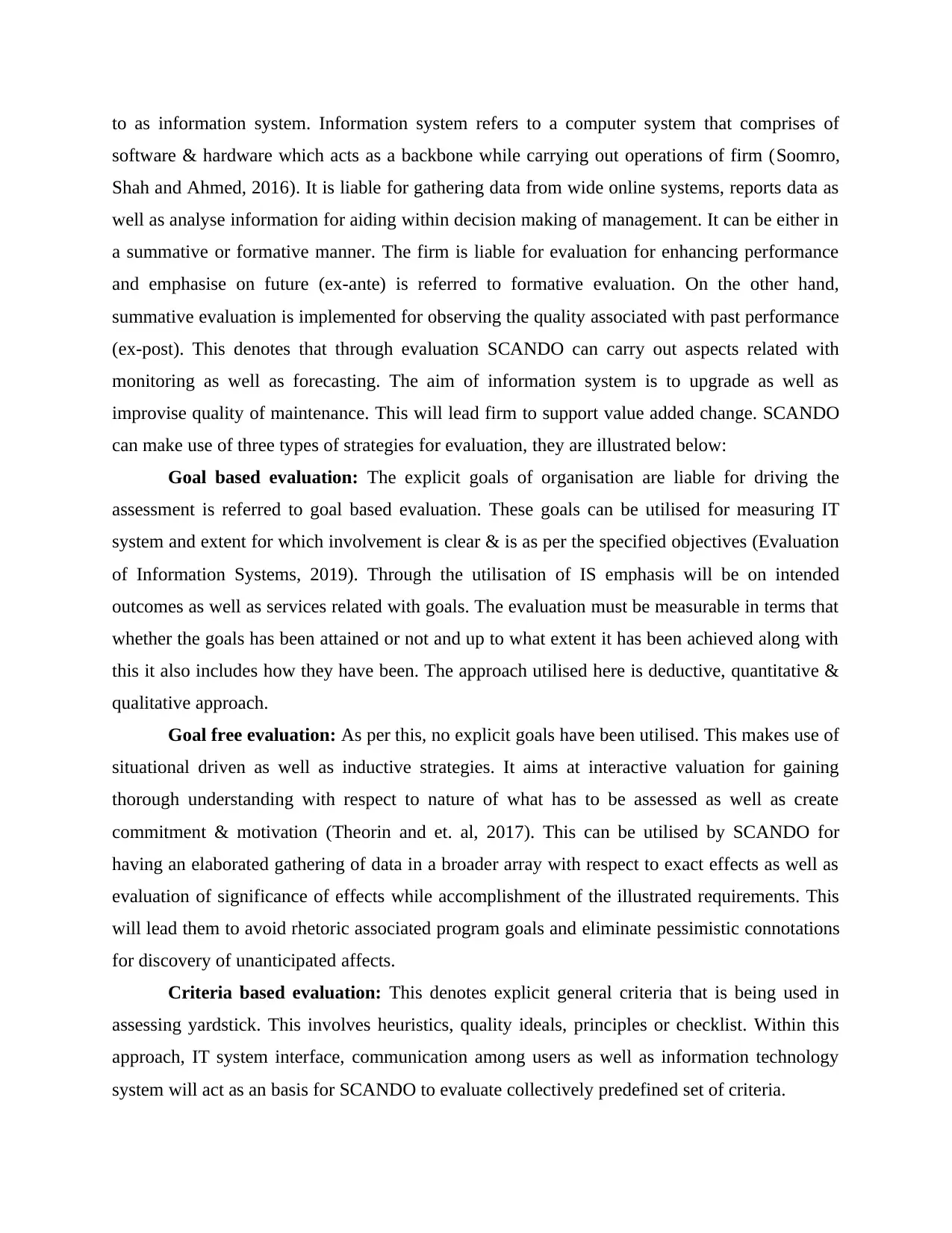
to as information system. Information system refers to a computer system that comprises of
software & hardware which acts as a backbone while carrying out operations of firm (Soomro,
Shah and Ahmed, 2016). It is liable for gathering data from wide online systems, reports data as
well as analyse information for aiding within decision making of management. It can be either in
a summative or formative manner. The firm is liable for evaluation for enhancing performance
and emphasise on future (ex-ante) is referred to formative evaluation. On the other hand,
summative evaluation is implemented for observing the quality associated with past performance
(ex-post). This denotes that through evaluation SCANDO can carry out aspects related with
monitoring as well as forecasting. The aim of information system is to upgrade as well as
improvise quality of maintenance. This will lead firm to support value added change. SCANDO
can make use of three types of strategies for evaluation, they are illustrated below:
Goal based evaluation: The explicit goals of organisation are liable for driving the
assessment is referred to goal based evaluation. These goals can be utilised for measuring IT
system and extent for which involvement is clear & is as per the specified objectives (Evaluation
of Information Systems, 2019). Through the utilisation of IS emphasis will be on intended
outcomes as well as services related with goals. The evaluation must be measurable in terms that
whether the goals has been attained or not and up to what extent it has been achieved along with
this it also includes how they have been. The approach utilised here is deductive, quantitative &
qualitative approach.
Goal free evaluation: As per this, no explicit goals have been utilised. This makes use of
situational driven as well as inductive strategies. It aims at interactive valuation for gaining
thorough understanding with respect to nature of what has to be assessed as well as create
commitment & motivation (Theorin and et. al, 2017). This can be utilised by SCANDO for
having an elaborated gathering of data in a broader array with respect to exact effects as well as
evaluation of significance of effects while accomplishment of the illustrated requirements. This
will lead them to avoid rhetoric associated program goals and eliminate pessimistic connotations
for discovery of unanticipated affects.
Criteria based evaluation: This denotes explicit general criteria that is being used in
assessing yardstick. This involves heuristics, quality ideals, principles or checklist. Within this
approach, IT system interface, communication among users as well as information technology
system will act as an basis for SCANDO to evaluate collectively predefined set of criteria.
software & hardware which acts as a backbone while carrying out operations of firm (Soomro,
Shah and Ahmed, 2016). It is liable for gathering data from wide online systems, reports data as
well as analyse information for aiding within decision making of management. It can be either in
a summative or formative manner. The firm is liable for evaluation for enhancing performance
and emphasise on future (ex-ante) is referred to formative evaluation. On the other hand,
summative evaluation is implemented for observing the quality associated with past performance
(ex-post). This denotes that through evaluation SCANDO can carry out aspects related with
monitoring as well as forecasting. The aim of information system is to upgrade as well as
improvise quality of maintenance. This will lead firm to support value added change. SCANDO
can make use of three types of strategies for evaluation, they are illustrated below:
Goal based evaluation: The explicit goals of organisation are liable for driving the
assessment is referred to goal based evaluation. These goals can be utilised for measuring IT
system and extent for which involvement is clear & is as per the specified objectives (Evaluation
of Information Systems, 2019). Through the utilisation of IS emphasis will be on intended
outcomes as well as services related with goals. The evaluation must be measurable in terms that
whether the goals has been attained or not and up to what extent it has been achieved along with
this it also includes how they have been. The approach utilised here is deductive, quantitative &
qualitative approach.
Goal free evaluation: As per this, no explicit goals have been utilised. This makes use of
situational driven as well as inductive strategies. It aims at interactive valuation for gaining
thorough understanding with respect to nature of what has to be assessed as well as create
commitment & motivation (Theorin and et. al, 2017). This can be utilised by SCANDO for
having an elaborated gathering of data in a broader array with respect to exact effects as well as
evaluation of significance of effects while accomplishment of the illustrated requirements. This
will lead them to avoid rhetoric associated program goals and eliminate pessimistic connotations
for discovery of unanticipated affects.
Criteria based evaluation: This denotes explicit general criteria that is being used in
assessing yardstick. This involves heuristics, quality ideals, principles or checklist. Within this
approach, IT system interface, communication among users as well as information technology
system will act as an basis for SCANDO to evaluate collectively predefined set of criteria.
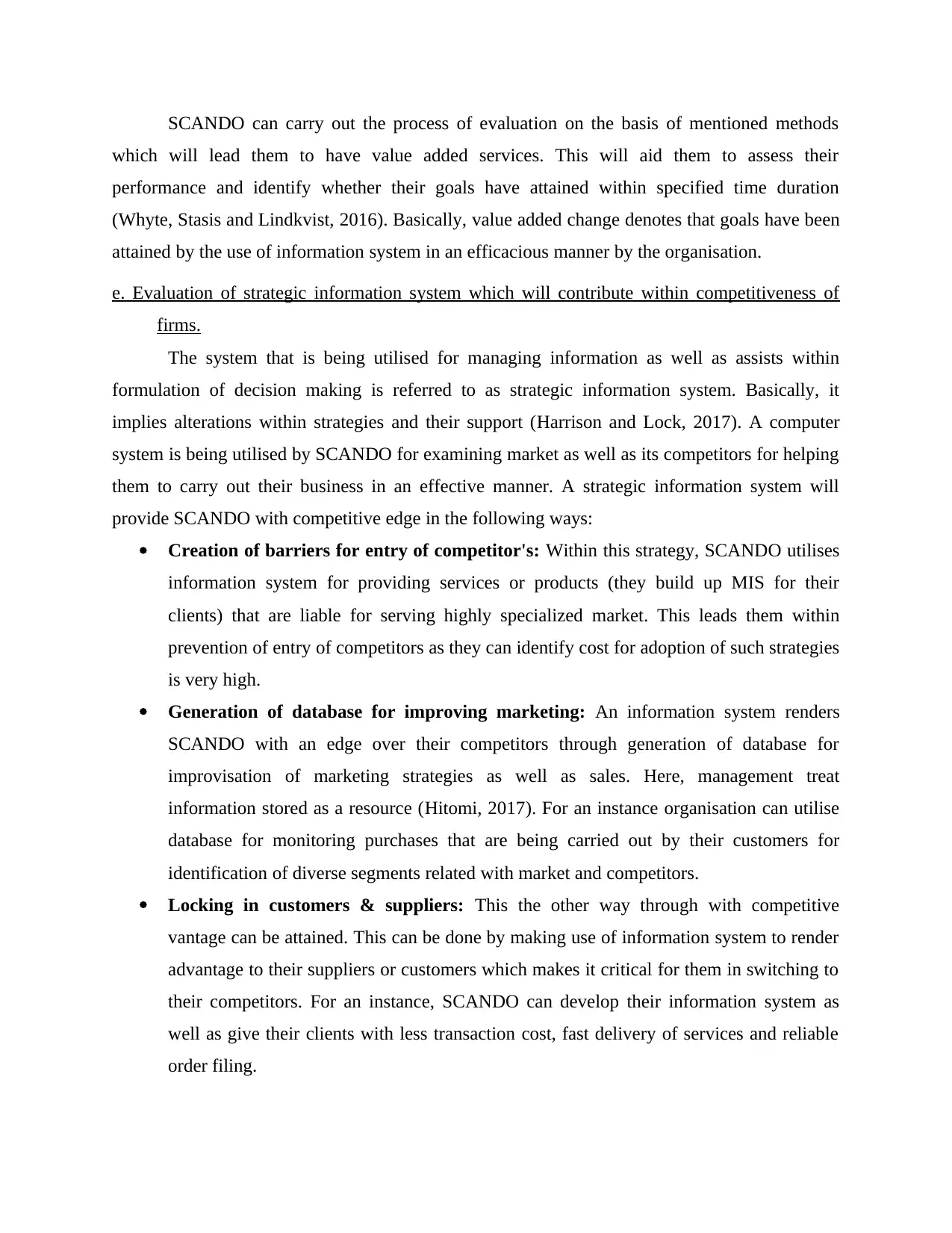
SCANDO can carry out the process of evaluation on the basis of mentioned methods
which will lead them to have value added services. This will aid them to assess their
performance and identify whether their goals have attained within specified time duration
(Whyte, Stasis and Lindkvist, 2016). Basically, value added change denotes that goals have been
attained by the use of information system in an efficacious manner by the organisation.
e. Evaluation of strategic information system which will contribute within competitiveness of
firms.
The system that is being utilised for managing information as well as assists within
formulation of decision making is referred to as strategic information system. Basically, it
implies alterations within strategies and their support (Harrison and Lock, 2017). A computer
system is being utilised by SCANDO for examining market as well as its competitors for helping
them to carry out their business in an effective manner. A strategic information system will
provide SCANDO with competitive edge in the following ways:
Creation of barriers for entry of competitor's: Within this strategy, SCANDO utilises
information system for providing services or products (they build up MIS for their
clients) that are liable for serving highly specialized market. This leads them within
prevention of entry of competitors as they can identify cost for adoption of such strategies
is very high.
Generation of database for improving marketing: An information system renders
SCANDO with an edge over their competitors through generation of database for
improvisation of marketing strategies as well as sales. Here, management treat
information stored as a resource (Hitomi, 2017). For an instance organisation can utilise
database for monitoring purchases that are being carried out by their customers for
identification of diverse segments related with market and competitors.
Locking in customers & suppliers: This the other way through with competitive
vantage can be attained. This can be done by making use of information system to render
advantage to their suppliers or customers which makes it critical for them in switching to
their competitors. For an instance, SCANDO can develop their information system as
well as give their clients with less transaction cost, fast delivery of services and reliable
order filing.
which will lead them to have value added services. This will aid them to assess their
performance and identify whether their goals have attained within specified time duration
(Whyte, Stasis and Lindkvist, 2016). Basically, value added change denotes that goals have been
attained by the use of information system in an efficacious manner by the organisation.
e. Evaluation of strategic information system which will contribute within competitiveness of
firms.
The system that is being utilised for managing information as well as assists within
formulation of decision making is referred to as strategic information system. Basically, it
implies alterations within strategies and their support (Harrison and Lock, 2017). A computer
system is being utilised by SCANDO for examining market as well as its competitors for helping
them to carry out their business in an effective manner. A strategic information system will
provide SCANDO with competitive edge in the following ways:
Creation of barriers for entry of competitor's: Within this strategy, SCANDO utilises
information system for providing services or products (they build up MIS for their
clients) that are liable for serving highly specialized market. This leads them within
prevention of entry of competitors as they can identify cost for adoption of such strategies
is very high.
Generation of database for improving marketing: An information system renders
SCANDO with an edge over their competitors through generation of database for
improvisation of marketing strategies as well as sales. Here, management treat
information stored as a resource (Hitomi, 2017). For an instance organisation can utilise
database for monitoring purchases that are being carried out by their customers for
identification of diverse segments related with market and competitors.
Locking in customers & suppliers: This the other way through with competitive
vantage can be attained. This can be done by making use of information system to render
advantage to their suppliers or customers which makes it critical for them in switching to
their competitors. For an instance, SCANDO can develop their information system as
well as give their clients with less transaction cost, fast delivery of services and reliable
order filing.
⊘ This is a preview!⊘
Do you want full access?
Subscribe today to unlock all pages.

Trusted by 1+ million students worldwide
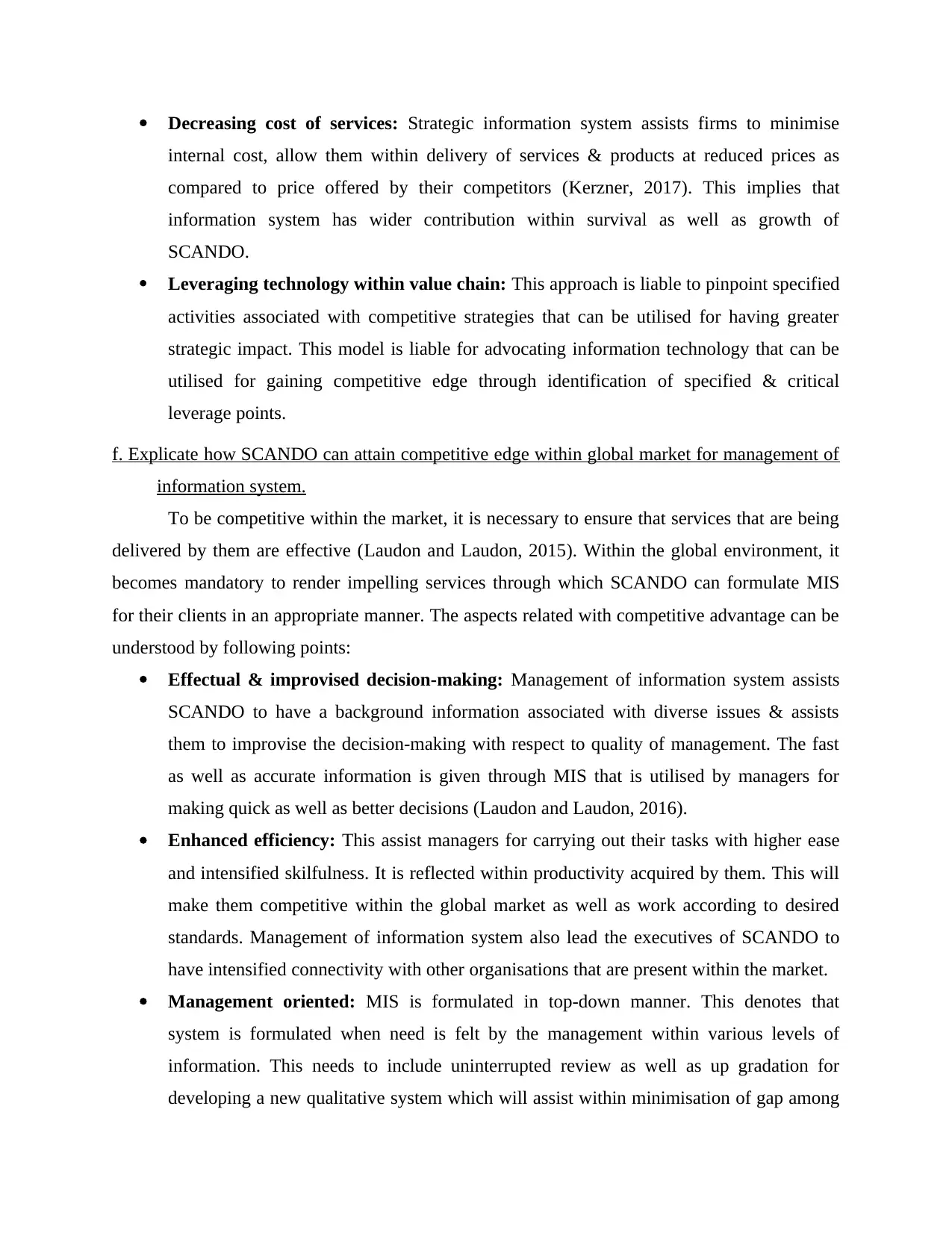
Decreasing cost of services: Strategic information system assists firms to minimise
internal cost, allow them within delivery of services & products at reduced prices as
compared to price offered by their competitors (Kerzner, 2017). This implies that
information system has wider contribution within survival as well as growth of
SCANDO.
Leveraging technology within value chain: This approach is liable to pinpoint specified
activities associated with competitive strategies that can be utilised for having greater
strategic impact. This model is liable for advocating information technology that can be
utilised for gaining competitive edge through identification of specified & critical
leverage points.
f. Explicate how SCANDO can attain competitive edge within global market for management of
information system.
To be competitive within the market, it is necessary to ensure that services that are being
delivered by them are effective (Laudon and Laudon, 2015). Within the global environment, it
becomes mandatory to render impelling services through which SCANDO can formulate MIS
for their clients in an appropriate manner. The aspects related with competitive advantage can be
understood by following points:
Effectual & improvised decision-making: Management of information system assists
SCANDO to have a background information associated with diverse issues & assists
them to improvise the decision-making with respect to quality of management. The fast
as well as accurate information is given through MIS that is utilised by managers for
making quick as well as better decisions (Laudon and Laudon, 2016).
Enhanced efficiency: This assist managers for carrying out their tasks with higher ease
and intensified skilfulness. It is reflected within productivity acquired by them. This will
make them competitive within the global market as well as work according to desired
standards. Management of information system also lead the executives of SCANDO to
have intensified connectivity with other organisations that are present within the market.
Management oriented: MIS is formulated in top-down manner. This denotes that
system is formulated when need is felt by the management within various levels of
information. This needs to include uninterrupted review as well as up gradation for
developing a new qualitative system which will assist within minimisation of gap among
internal cost, allow them within delivery of services & products at reduced prices as
compared to price offered by their competitors (Kerzner, 2017). This implies that
information system has wider contribution within survival as well as growth of
SCANDO.
Leveraging technology within value chain: This approach is liable to pinpoint specified
activities associated with competitive strategies that can be utilised for having greater
strategic impact. This model is liable for advocating information technology that can be
utilised for gaining competitive edge through identification of specified & critical
leverage points.
f. Explicate how SCANDO can attain competitive edge within global market for management of
information system.
To be competitive within the market, it is necessary to ensure that services that are being
delivered by them are effective (Laudon and Laudon, 2015). Within the global environment, it
becomes mandatory to render impelling services through which SCANDO can formulate MIS
for their clients in an appropriate manner. The aspects related with competitive advantage can be
understood by following points:
Effectual & improvised decision-making: Management of information system assists
SCANDO to have a background information associated with diverse issues & assists
them to improvise the decision-making with respect to quality of management. The fast
as well as accurate information is given through MIS that is utilised by managers for
making quick as well as better decisions (Laudon and Laudon, 2016).
Enhanced efficiency: This assist managers for carrying out their tasks with higher ease
and intensified skilfulness. It is reflected within productivity acquired by them. This will
make them competitive within the global market as well as work according to desired
standards. Management of information system also lead the executives of SCANDO to
have intensified connectivity with other organisations that are present within the market.
Management oriented: MIS is formulated in top-down manner. This denotes that
system is formulated when need is felt by the management within various levels of
information. This needs to include uninterrupted review as well as up gradation for
developing a new qualitative system which will assist within minimisation of gap among
Paraphrase This Document
Need a fresh take? Get an instant paraphrase of this document with our AI Paraphraser
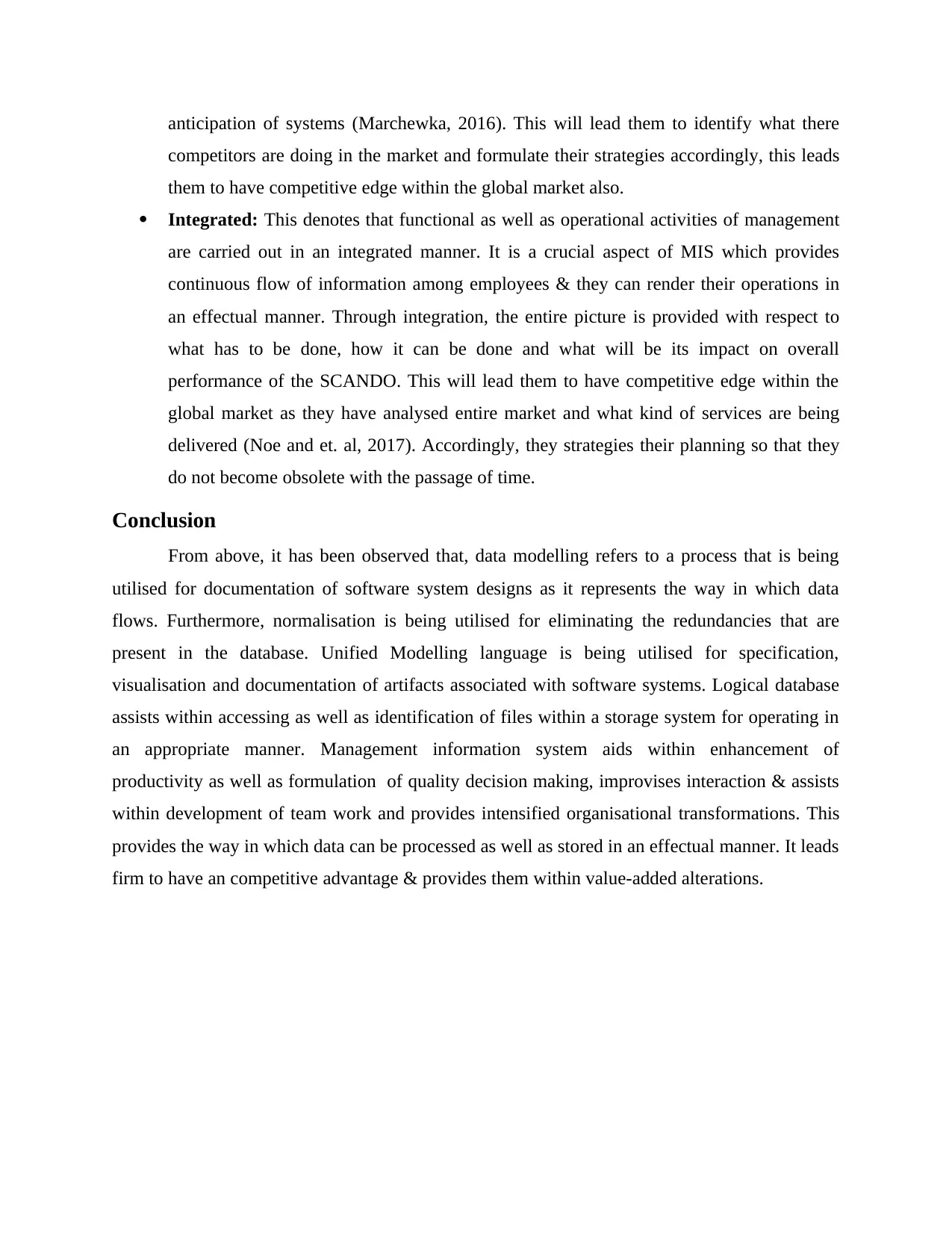
anticipation of systems (Marchewka, 2016). This will lead them to identify what there
competitors are doing in the market and formulate their strategies accordingly, this leads
them to have competitive edge within the global market also.
Integrated: This denotes that functional as well as operational activities of management
are carried out in an integrated manner. It is a crucial aspect of MIS which provides
continuous flow of information among employees & they can render their operations in
an effectual manner. Through integration, the entire picture is provided with respect to
what has to be done, how it can be done and what will be its impact on overall
performance of the SCANDO. This will lead them to have competitive edge within the
global market as they have analysed entire market and what kind of services are being
delivered (Noe and et. al, 2017). Accordingly, they strategies their planning so that they
do not become obsolete with the passage of time.
Conclusion
From above, it has been observed that, data modelling refers to a process that is being
utilised for documentation of software system designs as it represents the way in which data
flows. Furthermore, normalisation is being utilised for eliminating the redundancies that are
present in the database. Unified Modelling language is being utilised for specification,
visualisation and documentation of artifacts associated with software systems. Logical database
assists within accessing as well as identification of files within a storage system for operating in
an appropriate manner. Management information system aids within enhancement of
productivity as well as formulation of quality decision making, improvises interaction & assists
within development of team work and provides intensified organisational transformations. This
provides the way in which data can be processed as well as stored in an effectual manner. It leads
firm to have an competitive advantage & provides them within value-added alterations.
competitors are doing in the market and formulate their strategies accordingly, this leads
them to have competitive edge within the global market also.
Integrated: This denotes that functional as well as operational activities of management
are carried out in an integrated manner. It is a crucial aspect of MIS which provides
continuous flow of information among employees & they can render their operations in
an effectual manner. Through integration, the entire picture is provided with respect to
what has to be done, how it can be done and what will be its impact on overall
performance of the SCANDO. This will lead them to have competitive edge within the
global market as they have analysed entire market and what kind of services are being
delivered (Noe and et. al, 2017). Accordingly, they strategies their planning so that they
do not become obsolete with the passage of time.
Conclusion
From above, it has been observed that, data modelling refers to a process that is being
utilised for documentation of software system designs as it represents the way in which data
flows. Furthermore, normalisation is being utilised for eliminating the redundancies that are
present in the database. Unified Modelling language is being utilised for specification,
visualisation and documentation of artifacts associated with software systems. Logical database
assists within accessing as well as identification of files within a storage system for operating in
an appropriate manner. Management information system aids within enhancement of
productivity as well as formulation of quality decision making, improvises interaction & assists
within development of team work and provides intensified organisational transformations. This
provides the way in which data can be processed as well as stored in an effectual manner. It leads
firm to have an competitive advantage & provides them within value-added alterations.
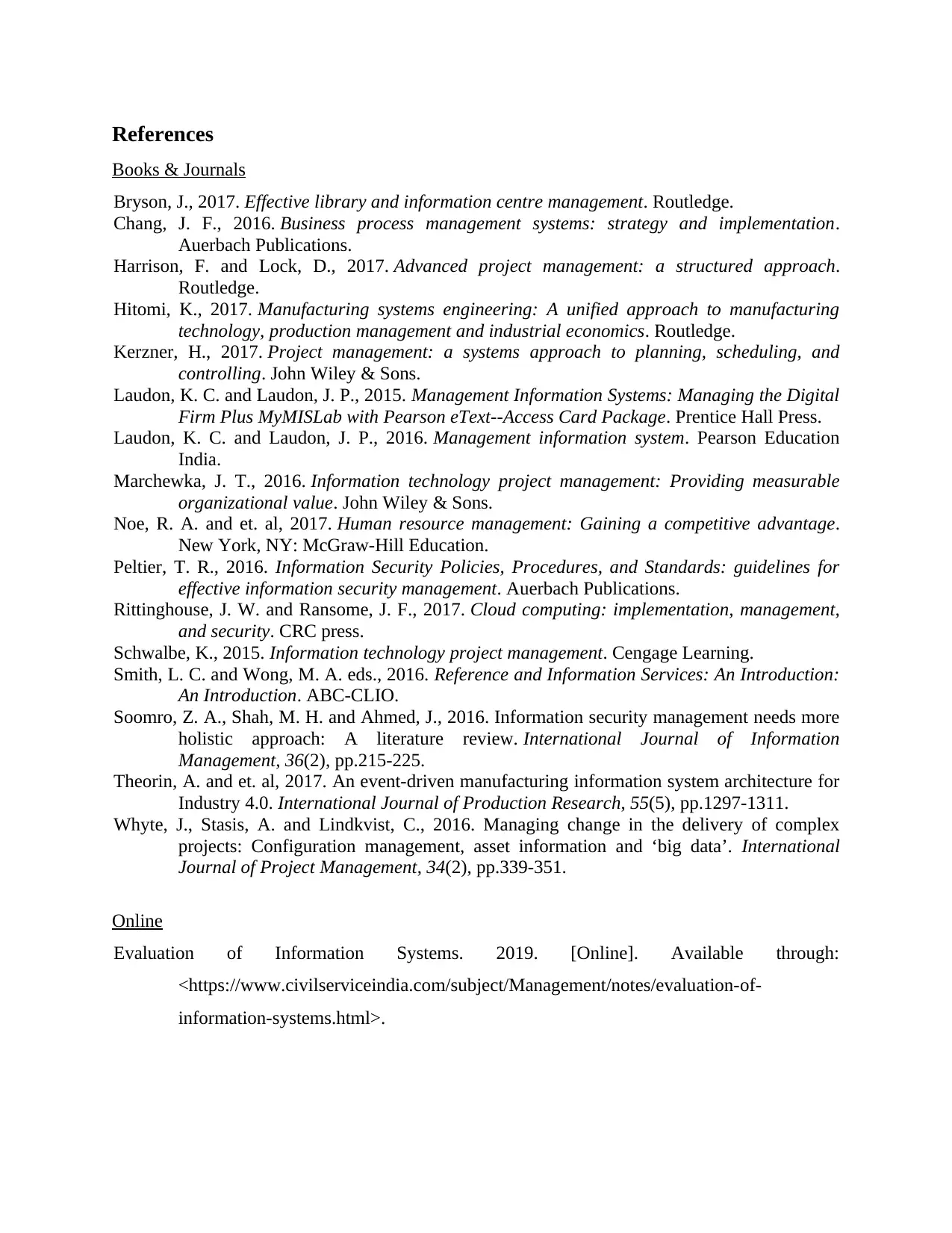
References
Books & Journals
Bryson, J., 2017. Effective library and information centre management. Routledge.
Chang, J. F., 2016. Business process management systems: strategy and implementation.
Auerbach Publications.
Harrison, F. and Lock, D., 2017. Advanced project management: a structured approach.
Routledge.
Hitomi, K., 2017. Manufacturing systems engineering: A unified approach to manufacturing
technology, production management and industrial economics. Routledge.
Kerzner, H., 2017. Project management: a systems approach to planning, scheduling, and
controlling. John Wiley & Sons.
Laudon, K. C. and Laudon, J. P., 2015. Management Information Systems: Managing the Digital
Firm Plus MyMISLab with Pearson eText--Access Card Package. Prentice Hall Press.
Laudon, K. C. and Laudon, J. P., 2016. Management information system. Pearson Education
India.
Marchewka, J. T., 2016. Information technology project management: Providing measurable
organizational value. John Wiley & Sons.
Noe, R. A. and et. al, 2017. Human resource management: Gaining a competitive advantage.
New York, NY: McGraw-Hill Education.
Peltier, T. R., 2016. Information Security Policies, Procedures, and Standards: guidelines for
effective information security management. Auerbach Publications.
Rittinghouse, J. W. and Ransome, J. F., 2017. Cloud computing: implementation, management,
and security. CRC press.
Schwalbe, K., 2015. Information technology project management. Cengage Learning.
Smith, L. C. and Wong, M. A. eds., 2016. Reference and Information Services: An Introduction:
An Introduction. ABC-CLIO.
Soomro, Z. A., Shah, M. H. and Ahmed, J., 2016. Information security management needs more
holistic approach: A literature review. International Journal of Information
Management, 36(2), pp.215-225.
Theorin, A. and et. al, 2017. An event-driven manufacturing information system architecture for
Industry 4.0. International Journal of Production Research, 55(5), pp.1297-1311.
Whyte, J., Stasis, A. and Lindkvist, C., 2016. Managing change in the delivery of complex
projects: Configuration management, asset information and ‘big data’. International
Journal of Project Management, 34(2), pp.339-351.
Online
Evaluation of Information Systems. 2019. [Online]. Available through:
<https://www.civilserviceindia.com/subject/Management/notes/evaluation-of-
information-systems.html>.
Books & Journals
Bryson, J., 2017. Effective library and information centre management. Routledge.
Chang, J. F., 2016. Business process management systems: strategy and implementation.
Auerbach Publications.
Harrison, F. and Lock, D., 2017. Advanced project management: a structured approach.
Routledge.
Hitomi, K., 2017. Manufacturing systems engineering: A unified approach to manufacturing
technology, production management and industrial economics. Routledge.
Kerzner, H., 2017. Project management: a systems approach to planning, scheduling, and
controlling. John Wiley & Sons.
Laudon, K. C. and Laudon, J. P., 2015. Management Information Systems: Managing the Digital
Firm Plus MyMISLab with Pearson eText--Access Card Package. Prentice Hall Press.
Laudon, K. C. and Laudon, J. P., 2016. Management information system. Pearson Education
India.
Marchewka, J. T., 2016. Information technology project management: Providing measurable
organizational value. John Wiley & Sons.
Noe, R. A. and et. al, 2017. Human resource management: Gaining a competitive advantage.
New York, NY: McGraw-Hill Education.
Peltier, T. R., 2016. Information Security Policies, Procedures, and Standards: guidelines for
effective information security management. Auerbach Publications.
Rittinghouse, J. W. and Ransome, J. F., 2017. Cloud computing: implementation, management,
and security. CRC press.
Schwalbe, K., 2015. Information technology project management. Cengage Learning.
Smith, L. C. and Wong, M. A. eds., 2016. Reference and Information Services: An Introduction:
An Introduction. ABC-CLIO.
Soomro, Z. A., Shah, M. H. and Ahmed, J., 2016. Information security management needs more
holistic approach: A literature review. International Journal of Information
Management, 36(2), pp.215-225.
Theorin, A. and et. al, 2017. An event-driven manufacturing information system architecture for
Industry 4.0. International Journal of Production Research, 55(5), pp.1297-1311.
Whyte, J., Stasis, A. and Lindkvist, C., 2016. Managing change in the delivery of complex
projects: Configuration management, asset information and ‘big data’. International
Journal of Project Management, 34(2), pp.339-351.
Online
Evaluation of Information Systems. 2019. [Online]. Available through:
<https://www.civilserviceindia.com/subject/Management/notes/evaluation-of-
information-systems.html>.
⊘ This is a preview!⊘
Do you want full access?
Subscribe today to unlock all pages.

Trusted by 1+ million students worldwide
1 out of 12
Related Documents
Your All-in-One AI-Powered Toolkit for Academic Success.
+13062052269
info@desklib.com
Available 24*7 on WhatsApp / Email
![[object Object]](/_next/static/media/star-bottom.7253800d.svg)
Unlock your academic potential
Copyright © 2020–2025 A2Z Services. All Rights Reserved. Developed and managed by ZUCOL.





